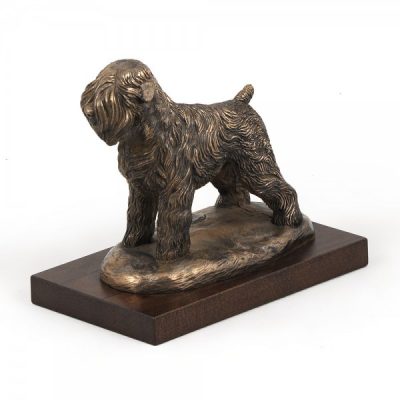
To their owners and breeders, they’re sometimes known as “Blackies,” and to admirers, they are the “Black Pearls of Russia.” Other names for the breed from around the world include Russian Bear Schnauzer, Tchiorny Terrier, Chornyi, Schwartzer Terrier, and even “Dooman” – half dog, half human (or in Russian – chelobaka). In the US, we know this magnificent breed as the Black Russian Terrier.
The BRT is one of the world’s newer breeds, having been created after WWII by the Central School of Military Breeding (aka the Red Star Kennel) founded in 1924 to breed and train military dogs by edict of the Russian Military Council. In the 1930’s, work began to develop a large, trainable, and hardy breed that would be part of the national security force at border crossings, prisons, and military installations. This was no easy feat since much of the purebred dog stock in the country had been slaughtered during the Russian Revolution, and more dogs died from distemper, economic disasters or in war.
Four main breeds were used to create the Black Russian Terrier: the Giant Schnauzer, the Rottweiler, the Airedale Terrier, and the Newfoundland, but a total of 17 breeds went into developing the new dog including the now-extinct Moscow Water Dog, Caucasian Ovcharka, East European Shepherd, Great Dane, Russian-Europian and East-Siberian Laikas, and German Shepherd Dog. Some sources speculate that the BRT was based on a foundation of 30% Giant Schnauzer, 30% Airedale Terrier and 30% Rottweiler, with the remaining 10% comprising the genetics of those other breeds. Other sources suggest that a Giant Schnauzer named “Roy” is considered to be the foundation dog of the breed for this reason: “Roy” was bred with different dams to produce dogs with black coats, but there were many failures that produced faults such as bad bites, cryptorchid and monorchid dogs (incomplete or partially descended testicles), and so forth. The Red Star Kennel’s Colonel G. Medvedev devised a plan: “Roy” was bred to Airedale Terrier bitches with the first litter resulting in 1951. The next step was to cross the Giant Schnauzer was crossed with the Rottweiller. The third step saw the Giant Schnauzer crossed with the Moscow Water Dog, and those hybrids were then crossed among themselves.
It was at the 1954 National Agricultural Exhibition that the Red Star Kennel showed off their results for which they received the coveted Gold Medal and diploma of excellence. In 1957, second and third generation BRT puppies were offered to private buyers and breeders, and this is where heads butted. The Red Star Kennel had created and bred the breed for guard duty and working ability. Private breeders favored more of an emphasis on temperament.
Breeding continued from 1958 to 1979, where trying a “little bit of this and a bit of that” still occurred, but finally in 1979, a standard for the Black Terrier breed was approved by the Red Star kennel. By then over 800 litters and well over 4,000 puppies had been produced, all of whom conformed to the standard. That the Soviet Army’s Red Star Kennel was able to get the BRT to breed true after only twenty of development using over 100 dogs from so many different breeds is somewhat astounding.
In 1981, the Black Terrier was accepted as a breed by the Russian authorities, and two years later, it gained acceptance by the FCI (which established and revised the breed standard in 1996). In 1992, the Black Terrier was renamed the Black Russian Terrier, and in 1996, the AKC listed the Black Russian Terrier with its Foundation Stock Service. In July 2004, the Black Russian Terrier was fully recognized and became part of the Working Group.
Today, the Black Russian Terrier has the joyous temperament and energy of the Airedale, the courage, stamina and strength of the Rottweiler and Giant Schnauzer, and the calm of the Newfoundland.
Black Russian Terrier sculpture made of Cold Cast Bronze by ArtDog is available here.

One thought on “A Snippet of Black Russian Terrier History”